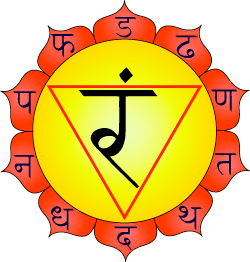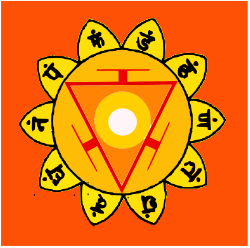Manipura

| Tantric chakras |
|---|
|
Sahasrara |
Manipura (Sanskrit: मणिपूर, IAST: Maṇipūra, English: "jewel city") is the third primary chakra according to Hindu tradition.
Description
Location
Located above the navel[1] or slightly below the solar plexus, Manipura translates from Sanskrit as the "City of Jewels" (Mani - gem, Pura or Puri - city). Manipura is often associated with the colors yellow,[2] blue in classical tantra,[3] and red in the Nath tradition.
Manipura is associated with fire and the power of transformation. It is said to govern digestion and metabolism as the home of Agni and the vital wind Samana Vayu. The energies of Prana Vayu and Apana Vayu (inward and outward flowing energy) meet at the point in a balanced system.
Manipura is the home of the coeliac plexus, which innervates most of the digestive system. In chakra-based medicine, practitioners work this area to promote healthier digestion, elimination, pancreas-kidney and Adrenal function. Weak Agni (fire) in the coeliac plexus leads to incompletely digested food, thoughts and emotions, and is a source of ama (toxicity).
Appearance
Manipura is represented with a downward-pointing red triangle, signifying the tattva of fire, within a bright yellow circle, with 10 dark-blue or black petals like heavily laden rain clouds.
The fire region is represented by the god Vahni, who is shining red, has four arms, holds a rosary and a spear. Vahni is making the gestures of granting boons, or favors, and dispelling fear. He is seated on a ram, the animal that represents Manipura.
Seed Mantra

The seed mantra is the syllable 'ram'. Within the bindu, or dot, above this mantra resides the deity Rudra. He is red or white, with three eyes, of ancient aspect with a silver beard, and is smeared with white ashes. Rudra makes the gestures of granting boons and dispelling fear and is seated either on a tiger skin or a bull.
Rudra's Shakti is the goddess Lakini. She has a black or dark-blue vermilion color; has three faces, each with three eyes; and is four-armed. Lakini holds a thunderbolt, the arrow shot from the bow of Kama, and fire. She makes the gestures of granting boons and dispelling fear. Lakini is seated on a red lotus.
Petals
The ten petals of Manipura are dark-blue or black, like heavily laden rain clouds, with the syllables ḍaṁ, ḍhaṁ, ṇaṁ, taṁ, thaṁ, daṁ, dhaṁ, naṁ, paṁ, and phaṁ upon them in a dark-blue color.
These petals correspond to the vrittis of spiritual ignorance, thirst, jealousy, treachery, shame, fear, disgust, delusion, foolishness and sadness.
Function
Manipura is considered the center of dynamism, energy, will power, and achievement (Itcha shakti), which radiates prana throughout the entire human body. It is associated with the power of fire and digestion, as well as with the sense of sight and the action of movement. Through meditating on Manipura, one is said to attain the power to create (save) or destroy the world.
Association with the body
The position of Manipura is stated as being either behind the navel or the solar plexus. Sometimes, when it is located at the navel, a secondary chakra called Surya (sun) chakra is located at the solar plexus, whose role is to absorb and assimilate Prana from the sun. Being related to the sense of sight, it is associated with the eyes, and being associated with movement, it is associated with the feet.[4]
In the endocrine system, Manipura is said to be associated with the pancreas and the outer adrenal glands (the adrenal cortex). These glands create important hormones involved in digestion, converting food into energy for the body, in the same way that Manipura radiates Prana throughout the body.
Practices
In kundalini and classical haṭha]] yoga, different practices for arousing and balancing the energies of Manipura include various asanas. These include Pranayama Uddiyana bandha (exhaling and pulling back and up the abdomen and diaphragm, respectively); agnisara kriya (practicing jalandhara bandha, and moving the abdomen in and out); nauli (stomach churning). Other pranayama and mudra encourage the union of prana and apana, where the lower and higher winds are made to unite.
Comparisons with other systems
Vajrayana
In Vajrayana traditions, the chakra is triangular, red and has 64 petals or channels that extend upwards. This chakra is important as the seat of the 'red drop'. The short syllable 'Ah' is located inside the 'red drop'.
Meditation on 'Ah' is the key component of the practice of tummo, or inner heat. In tummo, a practitioner's 'subtle winds' are made to enter the central channel, and rise up to its top. This is sometimes compared to 'Raising the kundalini' in Hindu terminology, melting the subtle white drop in the crown, and causing an experience of great bliss. 'Raising the kundalini' is considered the first and most important of the six yogas of Naropa.[5]
Qigong
In Chinese qigong, there are three Dantians that act as furnaces to convert different energies in the body. The lower Dantian exists in the stomach region. Its function is to convert sexual jing energy into Qi energy (a concept similar to Hindu prana).
Lataif-e-sitta
Within the Sufi Lataif-e-sitta, the torso contains several Lataif. Unlike the charas, the Lataif are not distributed vertically, instead to the left and the right. The nafs, or lower self, is a centre that is situated below the navel.
Kabbala
Western occultists make different kabbalistic associations with Manipura. For some occultists, it relates to the sephirot of Hod and Netzach.
Netzach is the quality of energy to overcome different obstacles.
Hod is the tendency to control and break down energy into different forms, the two forms being contending and balancing forces. This is like the forces of anabolism and catabolism in the human body. Hod and Netzach are associated with the left and right legs and feet of the body.[6]
Alternative names
- Tantra: Dashachchada, Dashadala Padma, Dashapatra, Dashapatrambuja, Manipura, Manipuraka, Nabhipadma, Nabhipankaja
- Vedas (late Upanishads): Manipura, Manipuraka, Nabhi Chakra
- Puranic: Manipura, Nabhi Chakra
References
- ↑ T. Krishnamacharya, Yoga Makaranda, p.10
- ↑ Solis, Michael (2011-11-29). Balancing the Chakras. Charles River Editors. ISBN 9781619828780.
- ↑ Sat Chakra Nirupana
- ↑ "Solar Plexus Chakra". ASIS Massage Education. Retrieved 27 August 2013.
- ↑ Geshe Kelsang Gyatso. Kundalini Grounds and Paths
- ↑ Leonara Leet. The universal kabbalah